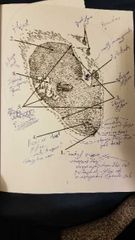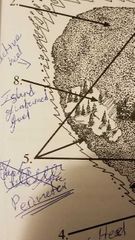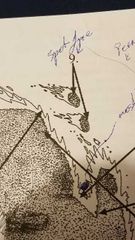![]()
![]()
![]()
Use LEFT and RIGHT arrow keys to navigate between flashcards;
Use UP and DOWN arrow keys to flip the card;
H to show hint;
A reads text to speech;
58 Cards in this Set
- Front
- Back
- 3rd side (hint)
|
PARTS OF THE FIRE |
Point of origin Head of a fire Flank of a fire Rear of a fire Fire perimeter Fingers of a fire Pockets Island Spot fire |

|
|
|
Point of origin |
The precise location where a competent Ignition source came into contact with the material 1st ignited and sustained combustion occurred |
|
|
|
Head of a fire |
The side of the fire having the fastest rate of spread |
|
|
|
Rear of a fire |
slope . That portion of A fire edge opposit of the head .That portion of a fire spreading directly into the wind or slope. That portion of A fire edge opposit of the head. Slowest spreading portion of a fire edge also called heal of a far . Slowest spreading portion of a fire edge also called heal of a far |
|
|
|
Fire perimeter |
The entire outer edge or boundary of a fire |
|
|
|
Finger of a fire |
The long narrow extensions of a fire projecting from the main body |

|
|
|
Pockets of a fire |
I'm burned indentations in the fire edge formed by fingers or slow burning areas |

|
|
|
Island |
Area or unburnt fuel inside the fire perimeter |

|
|
|
Spot fire |
Fire ignited outside the premitur of the main fire by a firebrand |

|
|
|
Fire behavioral terms |
Smoldering Creeping fire Running fire Spotting Torching Crown fire Flare up Firewhirl Backing fire Flaming front |
|
|
|
Smoldering |
Fire burning without flame and barely spreading |
|
|
|
Creeping fire |
Fire burning with the low flame and spreading slowly |
|
|
|
Running fire |
Behavior of a fire spreading rapidly with a well defined head |
Never want to be in front of that |
|
|
Spotting |
Behavior of a fire producing sparks or embers that are carried by the wind and which start new fires beyond the zone of direct Ignition by the main fire |
Wind spreading Amber starting a new fire, cow poop ignites because of heat |
|
|
Torching |
The burning of the foliage of a single tree or a small group of trees, from the bottom up |
|
|
|
Crown fire |
A fire that advances from top to top of trees or shrubs more or less independent of a surface. Crown fires are sometimes classed as running or dependent to distinguish the degree of independence from the surface fire. |
|
|
|
Flair up |
Any sudden acceleration in the rate of spread or intensification of the file. unlike blow up, a flareup is of relatively short duration and does not change existing control plans |
|
|
|
Fire whirl |
Spinning vortex column of ascending hot air and gasses rising from the fire and carrying aloft smoke, debris, and flame. fire whirls range in sizes from less than 1' over 500' in diameter. larger fires whirls have the intensity of the small tornado |
|
|
|
Backing fire/ Heal fire |
That portion of the fire with slower rates of fire spread and lower intensity, normally moving into the wind and/or downslope. also called heal fire |
|
|
|
Flaming front |
A zone of a moving fire where the combustion is primarily flaming |
|
|
|
Other useful firefighting terms |
Anchor point Control line Fire line Mop up Contained Controlled Chain |
|
|
|
Anchor point |
An advantageous location, usually a barrier of fire spread, from which to start constructing a fire line. the anchor point is used to minimize the chance of being flanked by the fire while the line is being constructed |
|
|
|
Control line |
An inclusive term for all constructed or natural barriers and treated fire edges used to contain a fire |
|
|
|
Fire line |
The part of a containment or control line that is scraped to mineral soil |
|
|
|
Mop up |
Extinguishing or removing burning material near control lines, felling snags,and trenching logs to prevent rolling after an area has burned, to make a fire safe, or to reduce residual smoke |
|
|
|
Contained |
The status of a wildfire suppression action signifying that a control line has been completed around the fire, and any associated spot fires, which can reasonably be expected to stop the fire spread |
|
|
|
Controlled |
The completion of a control line around a fire, any spot fires, and any interior islands to be saved |
|
|
|
Chain |
Unit of measure in land survey, equal to 66 feet, 80 chains equal one mile |
|
|
|
What is the fire triangle |
Heat, oxygen, fuel. Fire goes out if you take one out |
We could off oxygen by throwing dirt to fire. Fire goes out if you take one out |
|
|
3 methods of heat transfer |
Radiation convection conduction |
|
|
|
Radiation |
Think of radiant heat as a ray or wave |
|
|
|
Convection |
Think of convection as a smoke column above the fire. convection occurs when lighter warm air moves upward. the hot gasses and embers which compose the smoke column can dry and ignite other fuels |
|
|
|
Conduction |
Think of conduction as a spoon in a hot drink, heat is conducted from one fuel particle to another in the same way, through direct contact |
|
|
|
When is a fire controlled |
When fire cannot start for under any reasonable conditions |
|
|
|
Should you fight fire with out in anger point and why |
No, because fire can flare up on you and you can become out flanked by the fire as well |
|
|
|
Sun rises in the East and sets in the West |
Far is are more dangerous around 2:00 p.m. |
|
|
|
Topography terms |
Aspect Slope Shape of country Box Canyons Narrow Canyons Wide Canyons Ridges Saddle Elevation Barriers |
|
|
|
Aspect |
Aspect is the direction a slope is facing ( its exposure in relation of the sun) |
North facing fuels have more shade which causes heavier fuels, lower temperatures, higher humidity, higher fuel moisture |
|
|
Slope |
The amount of degree of incline of a hillside ( a steep slope). |
|
|
|
Shape of country |
Terrain features ( can influence wind features) |
|
|
|
Box canyons |
Air will be drawn in from the canyon bottom creating very strong upslope drafts |
|
|
|
Narrow canyons |
Fire in steep narrow canyon can easily spread to fuels on the opposite side by radiation and spotting. |
|
|
|
Wide canyons |
Prevailing wind direction. Can be altered by the direction of the canyon |
|
|
|
Ridges |
Fire burning along lateral ridges may change direction when they reach a point where their ridges drop off into a Canyon this change of direction is caused by the flow of air in the Canyon |
|
|
|
Saddle |
When blowing through a saddle or pass in the mountain range can increase in speed as it passes through the constricted area and spreads out on the downwind side with possible eddy action |
|
|
|
Elevation |
Elevation usually plays a large roll in determining the conditions and the amount of fuel |
|
|
|
Barriers |
Spurce that blocks fire, Can be natural or man made |
|
|
|
Under normal conditions, a north north facing aspect will have more fire activity than a south facing aspect |
False |
|
|
|
Box canyons are dangerous because ... |
Heat rises making fire run up slope |
|
|
|
Fuel types |
Grass Grass shrub Shrub Timber understory Timber litter Slash blowdown |
|
|
|
Timber understory |
* found throughout most areas * provides ladder to a real crown fuels |
|
|
|
Timber litter |
*Most dominant in mountains terrain, especially in northwest *provides fuel for ground fire |
|
|
|
Slash blow down |
Debris left after natural events or human activities |
Logs Chunks of wood Bark Branches Stumps Broken understory trees Shrubs |
|
|
CHARICTORISTICS THE INFLUENCE THE BEHAVIOR OF THE FIRE |
Fuel type Fuel loading Fuel availability Fuel arrangement Fuel moisture |
|
|
|
Uniformed fuels |
Fuels distributed continuously over the area |
|
|
|
Ladder Fuels |
Combustible materials that aid the spread of fire from the surface to the upper canopy |
|
|
|
Fuel timelag |
The rate at which dead fuel gains or loses moisture |
|
|
|
Surface fuels |
All combistuable materials lying on or immediately above the ground |
|

